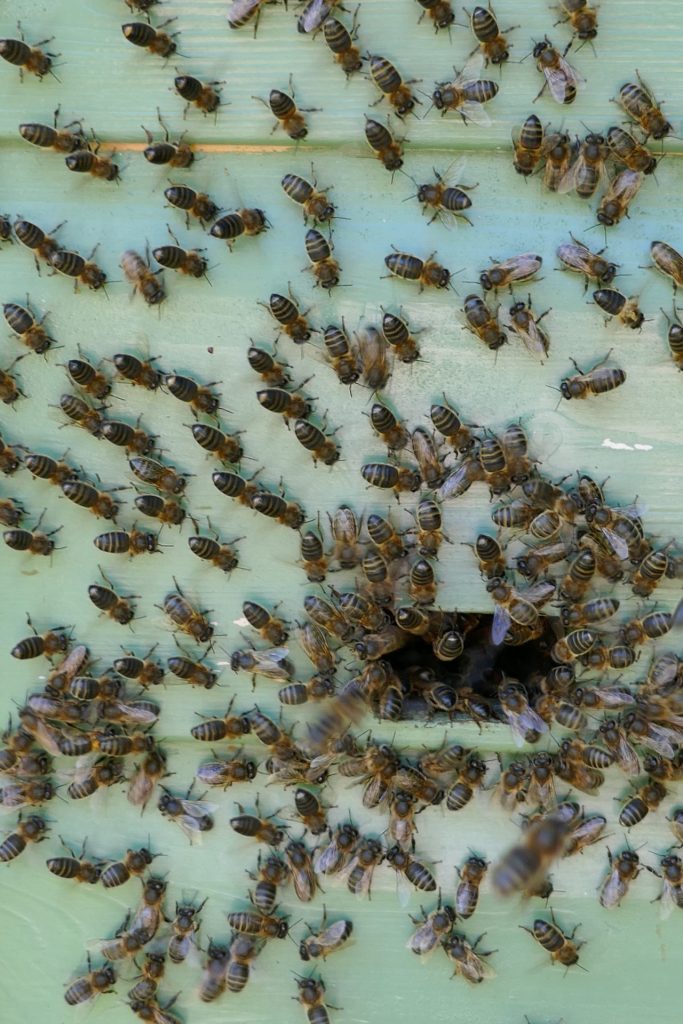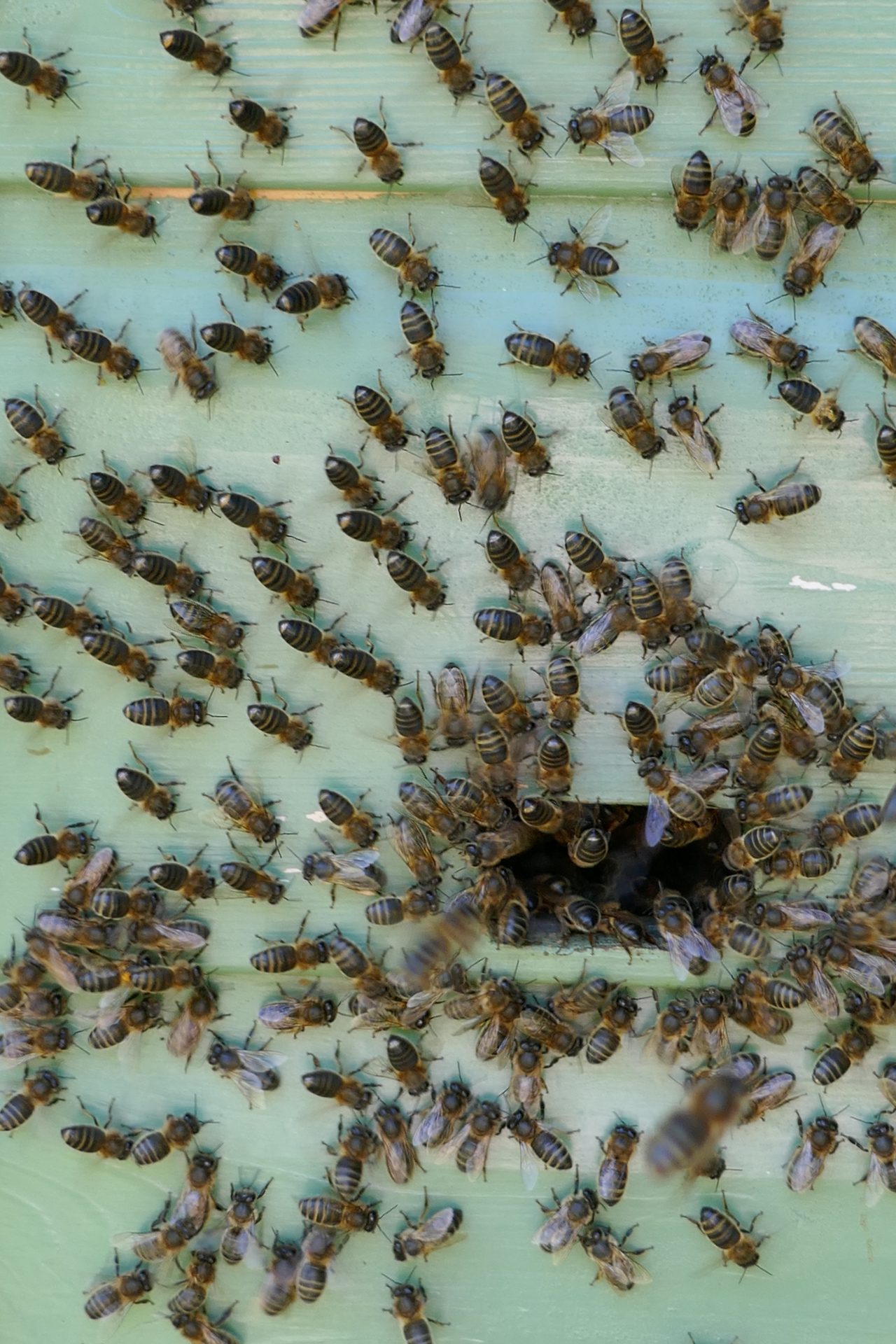
February races forward with mixed days of bracing gales, heavy horizontal rain, flooding and freezing blizzard conditions. On the rare sunny warmish days this month, the bees have all been out on cleansing flights and taking advantage of some shelter and warmth on any flowering shrub that they can find. On one of these days, I sit with a coffee in the rocker out front and soon a bee arrives to investigate my hand which probably smells of floral soap. I sense the desperation as she searches my hand thoroughly, crawling between my fingers and up my sleeve in search of food. I’m relieved when she emerges from the sleeve unscathed and flies off again. But how confusing for bees to have such changeable unpredictable weather patterns.
I’m aware that soon the hard working beekeepers taking modules will be sitting exams in late March, so this week’s blog is dedicated to everyone working on bee behaviour.
Communication.
We humans communicate with each other in so many different ways it is astounding really. We can use verbal communication and openly deliver our messages through speech, or we can write them down on paper. We can use covert subtle and nuanced signals to convey information about ourselves, for example, by dressing in a particular way or, by folding our arms across our chests in a defiant pose. Unconsciously, we can convey feelings of anxiety by perspiring profusely, or flushing red above the neckline; managers may recall interviewees sitting hunched up on the edges of their chairs with tightly clenched hands clearly nervous.
Honey bees communicate many things through signals and cues, and so we and they are much alike in this respect. Also, human beings and honey bees share something special; we are the only animals that can tell one another the locations of importance resources, such as excellent sources of food. We do this whenever we guide friends to an outstanding restaurant by giving them clear driving directions. Honey bees do this when they steer their hive mates to rich flower patches by performing waggle dances.
Waggle Dance.
Today, most honey bee biologists acknowledge only two dances performed by honey bees; the waggle dance and the tremble dance. The waggle dance tells a nestmate the direction and distance to go to a rich food source (or water source, or home site) while the tremble dance activates resting receiver bees during a nectar flow when foragers find it difficult to get nectar unloaded on return to the hive.
Signals.
A signal¹ is defined by scientists as a structure or behaviour that has been shaped by natural selection for the purpose of conveying information. The signals of honey bees have evolved to be easily detected inside the dark nest or hive, and these are mainly chemical and mechanical stimuli. Pheromones are chemicals secreted from exocrine glands that release odours to the outside of the body and give information to other individuals of the same species. Endocrine glands however, release chemicals into the bloodstream and give information to other organs in the individual’s body.
Honey bees possess at least 21 known signals, and over half are pheromones². These include the worker-produced Nasonov pheromone which functions to attract nestmates, and the queen-produced mandibular gland pheromone (QMP) which indicates the presence of a queen. Circulating QMP helps maintain colony cohesion by suppressing the building of queen cells.
Mechanical signals include the waggle and tremble dances, shaking signal, sometimes called the dorsoventral abdominal vibration signal, or (DVAV), buzz run, grooming invitation, antennation signal and worker piping. There are two forms of worker piping, wings -together and wings- apart. We know that the message of the wings-together is “warm up your flight muscles”. Queen piping, indicting the presence of a queen, is the only known queen-produced mechanical signal³.
Cues.
Cues are information variables perceived by a bee that have not been shaped by natural selection to intentionally impart information; instead, a cue conveys information incidentally. An example of a chemical cue is the floral odour on a waggle dancer. It incidentally indicates the type of flower visited by the dancing bee. The floral odour cue comes about as a by-product of finding and foraging on the flower. Worker bees get information from different cues, some of which are chemical cues. There are also tactile cues, time cues (e.g., how long it takes a pollen collector to find an empty cell for her pollen loads) and visual cues.
I’ve researched the literature and, using Tom Seeley’s work, I’ve copied the following lists for you from a paper on information and integration in honey bee colonies4.
Worker-produced chemical signals.
Nasonov gland pheromone: associated function is attraction of nestmates
Footprint pheromone: orientation of nestmates
Sting gland pheromone: evoking aggression
Mandibular gland pheromone: evoking aggression
Brood pheromone: recognition of brood by nurse bees involved with feeding etc.
Queen-produced Chemical Signals.
Mandibular gland pheromone: indication of queen’s presence
Dufour gland pheromone: recognition of queen-laid eggs
Tergal gland pheromones: thought to attract workers
Footprint pheromone: thought to be involved with inhibition of queen rearing
Worker-produced mechanical signals.
Waggle dance: recruitment to food sources and nest sites
Tremble dance: activation of receiver bees
Shaking signal (DVAV): activation of workers
Buzz run: indication of swarm departure
Grooming invitation: invitation to groom
Worker Piping: instructions to “warm up your flight muscles for departure”
Queen-produced Mechanical Signals.
Queen piping: indication of queen’s presence.
Cues.
Chemical Cues.
Floral odour on waggle dancer: used to indicate flower type
Colony odour: recognition of nestmates
Carbon dioxide level in hive atmosphere: indicates hive ventilation need
Dead bee odour: indicates dead bee and need to remove
Empty comb odour: indication of empty comb
Dead or diseased brood odour: recognition of dead or diseased brood
Pollen odour on waggle dancer: recognition of dancer carrying pollen
Propolis odour on waggle dancer: recognition of dancer bearing propolis
Odour of cell contents: indication of brood or food, or of empty cells needing cleaning or indication of brood needing to be fed
Dry or hungry brood: indication of brood needing to be fed
Tactile Cues.
Cell wall thickness: indication of the need for cell wall planning
Cell size (worker or drone: recognition of cell type
Partially capped cell: indicates need for cell capping
Incomplete cell: indication of need for cell building
Ragged cell cappings: indication of need for trimming cell cappings
Unpacked pollen loads in cells: indication of need for packing pollen
Debris inside the hive: indication of need to remove hive debris
Debris on self: indication of need for grooming
Bare nest- cavity walls: indication of need to propolize cavity walls
Drafts of cold air: indication of cracks needing to be sealed with propolis
Congestion of nestmates: indication of colony strength.
Vibration of nest: indication of disturbance by a predator
Number of unloading rejections by receiver bees: indication of colony’s need for more water
Abundance of drone cells: indication of colony’s need for more drone cells
Orientation of larvae in cells: indication of where to place food in cell
Time Cues.
Time spent searching for a nectar receiver bee: indication of colony’s need for higher nectar inflow
Time spent searching for a water receiver bee: indication of colony’s need for higher water inflow
Time spent searching for a nectar forager: indication of colony’s need for nectar receivers
Time spent searching for a cell containing pollen: indication of colony’s pollen reserve
Visual Cues.
Light coming into the entrance opening: indication of the exit direction
Temperature Cues.
Temperature inside the hive: indication of need for heating or cooling the nest.
References.
¹ ² 4 Seeley TD (1998) Thoughts on Information and Integrations in Honey Bee colonies, Apidologie 29 (1998) 67-80
³ Seeley, Thomas D. (2010) Honeybee Democracy (page 154), Princeton University Press, New Jersey.


Wonderful revision and new information, Ann.
A question: re the “time” section- how long do honey bees take to search, then communicate to each other before addressing an issue?
I always feel that bees are on a different time scale from us humans – they seem to “act” faster – or maybe this is just because I can’t “see”pheromones therefore I’m not speaking their language?
Jane
Hello Jane. Thank you for commenting and thinking about these amazing forms of animal communications. I can’t answer this question in the detail that I expect you want. I am not sure that this has even been studied. Given the large number of plate receptors on the antennae, and the acute sense of smell of honey bees, I am guessing that reaction depends on the time taken for pheromones to be picked up, and this could vary according to factors such as weather, warmth, humidity, wind etc outside. Inside conditions such as overcrowding affect the circulating queen pheromone. I do know that if I knock the hive while mowing the lawn, the bees are out in a flash and the guard bees are doing their stuff. So responses are mostly fast I think.
Hello 2Bees, I’m delighted that you want to share my article on communication, and thank you for commenting.
Best wishes, Ann
Very interesting read !!
I’m really glad that you enjoyed reading this, Jane. Thank you for commenting on it.
Best wishes, Ann.
I am not a beekeeper but a gardener and it never ceases to amaze me how wonderful bees are. It is truly amazing how complicated their behaviour is.
I really enjoyed the article.
Hello Mary. I’m pleased that you enjoyed the piece and thank you for commenting. Gardening and beekeeping are closely linked so we have common interests there. Best wishes, Ann.